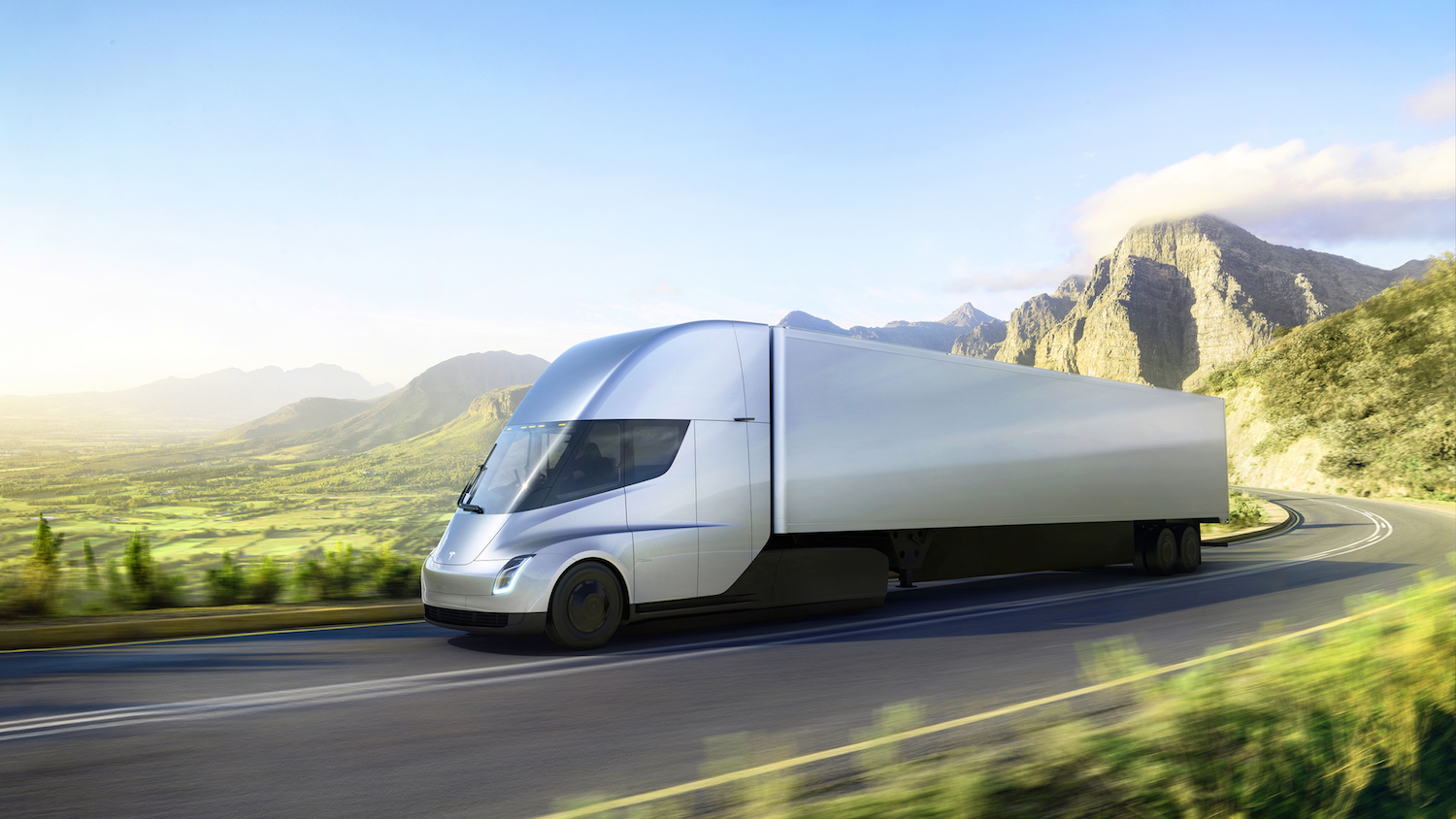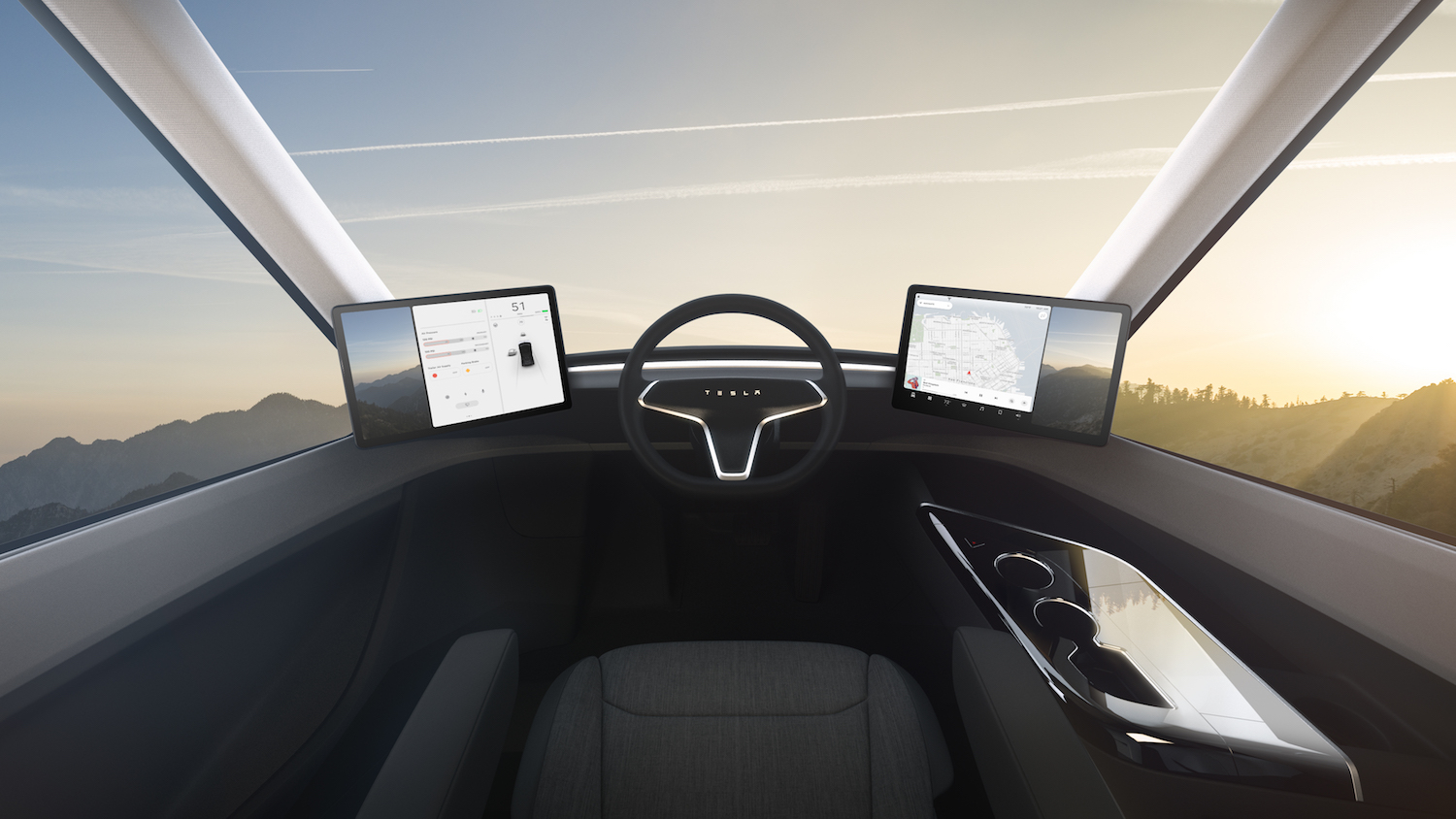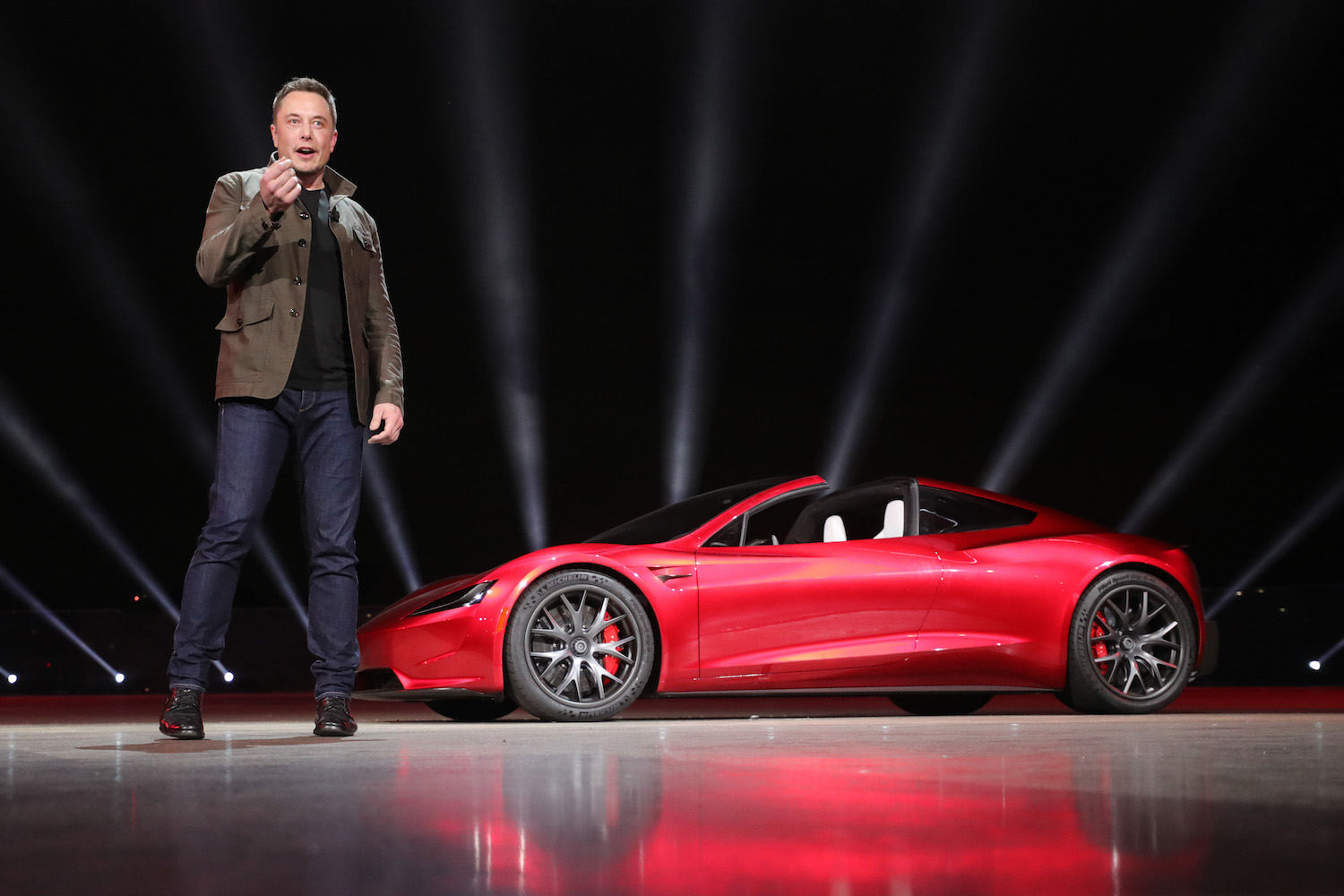This evening we didn’t have the second coming of Christ, but we did see a couple nigh-on-impossible vehicles announced. A semi-truck that does 0-60 miles/hr in 5 seconds? (unloaded) And a 4-seater sports car that does 0-60 miles/hr in 1.9 seconds? And, the truck will be available in 2019, and the Roadster 2 will be available in 2020? For the truck, Elon Musk promised a lower cost of ownership than a diesel truck, especially if the truck is operating in a “Convoy”. Musk promised us we’d have our minds blown by this announcement, and it sure is exciting and beyond what I expected. So lets calm down and consider this carefully.
Costs around operating a big truck include fuel, maintenance, downtime, risks of accidents, and whether it effectively works a route. The Tesla Semi has a great story on all those points.
The speed/performance of this truck is not so it can beat dragsters at a race track. There’s a practical purpose to why the Tesla Semi outperforms a diesel truck – and that’s so the truck has better compatibility with other vehicles on the road (safety), and to get to the destination more quickly so it can deliver more loads in a given time-frame.
Fully loaded with a 40-ton trailer (80,000 lbs of cargo) the Semi does 0-60 miles/hr in 20 seconds which is enormously faster than a diesel Semi. It climbs mountains at full speed, 65 miles/hr, rather than the 45 miles/hr that a diesel truck crawls up a mountain. With the four-motor drive-train, the Semi handles better than any diesel truck, plus they’re guaranteeing that the Semi cannot jack-knife, and that the low center of gravity (that battery weight) means it is highly unlikely to tip over. In other words, from a practical usability point of view truck drivers are likely to like the Tesla Semi a lot.
But the fleet owner will be wondering — costs. Elon Musk claimed $1.25/mile for a single truck, and $0.85/mile for a 3-truck “Convoy”, versus $1.51/mile for a diesel truck. That was on a 100 mile route with Diesel at $2/gallon (which is very cheap), and $0.07/kWh electricity. This should make fleet owners sit up and take notice in a big way.

The Semi should be capable of handling long-haul trucking — IF Tesla motors follows through and installs the Megacharger’s along long-haul trucking routes. How? First, the Semi has a 500 mile range, which is enormously bigger than I’d have expected for a full-scale class 8 truck (fully loaded, by the way). Further, at a Megacharger the Semi will recharge 400 miles of range in 30 minutes.
Okay – Megacharger? That was mentioned in passing, and it’s a new thing. Obviously Megacharger is a next step above Supercharger, and named by the management of a company run by Geeks. Musk did not say the battery capacity of the Semi, nor did he say the charging rate of the Megacharger. But there are two observations. First is that the charging rate equates to about C/2 which is in line with existing battery technology, meaning that Tesla is not making the Tesla Semi contingent on a breakthrough in battery technology offering a higher charge rate. Instead it’s gonna be using battery cells similar to what’s installed in existing vehicles because they too charge at about a C/2 rate. (C/2 means a 1/2 hour full charge time)
Second, is that the charge rate will be well above 350 kiloWatts. How do I know that?
Not knowing the energy storage capacity of the Tesla Semi hampers my ability to say this clearly. But, getting a 500 mile range on a fully loaded class 8 truck should take a heck of a lot of kiloWatt-hours and maybe even a megaWatt-hour of energy storage. Charging that in 1/2 hour means a charge rate in the neighborhood of 1 megaWatt? Wild ass guess.
Third thing is that Musk made no mention of whether Megacharger would be available for Tesla’s passenger cars. It’s highly unlikely, however, for the reason I mentioned above. The charge rate needs to stay at-or-below C/2, meaning a 1/2 hour charge rate. A 100 kWh vehicle must therefore stay below a 200 kiloWatt charge rate. For passenger cars Tesla Motors is unlikely to go much beyond a 100 kWh capacity, so therefore the Megacharger’s are completely unnecessary for a car. Well, the Roadster 2 might be an exception.
A key to implementing this performance is – aerodynamics. Namely a 0.35 drag coefficient on the Tesla Semi, which is enormously better than regular class 8 trucks that have the aerodynamics of a brick wall. It means that Tesla is paying attention to physics and realizing that long range can be achieved with efficiency.
A practical thing about the charge rate is driver downtime. Government regulations require truck drivers take a certain amount of downtime while on the road. The 500 mile range means the driver could go for 4-6 hours then stop at a Megacharger station, and they’d have a half hour or so to take care of human needs. Presumably they could do two of those stints in a day, then stop at a motel for a nights sleep.

The Tesla Semi includes two touch-screen displays with a ton of built-in infotainment and navigation systems. Elon claimed that existing truck owners must integrate a lot of 3rd party systems at a high cost to implement what Tesla will deliver out of the box.
Earlier I mentioned “Convoy”. Musk didn’t mean this:
What precisely he meant wasn’t spelled out. The image shown at that moment showed 3 trucks on a freeway traveling rather close together. Leading me to believe he means a specific thing I read about several years ago — the “Road Train”.
The Road Train concept involves vehicles with highly functioning autonomous driving capability, traveling extremely close together. The aerodynamics of the vehicles would work together synergistically to increase efficiency of the Road Train as a whole. The concept relies on the theory that a computer can react more quickly to a “SITUATION” than a human could, and therefore autonomous vehicles can safely drive extremely close together when a human would be completely incapable.
While Musk didn’t say the phrase Road Train, it’s clear that’s what he means.
Musk did say the Semi will come standard with autopilot hardware and include automatic braking, lane keeping, and collision warning capabilities. All that’s gonna improve not only driver safety but the safety of other people on the road. For example how many bicyclists and pedestrians get killed by being run over by a big truck? Decreasing that occurrence would be fantastic.
The most important thing is cost of ownership drops to $0.85/mile when operating in a Convoy. And, oh, maybe just maybe in 2030 or so Tesla will have fully autonomized these Semi’s so that only the front truck has to be manned, and the trailing trucks are slaved to the front truck. I do NOT look forward to competing on the road against that. But, Elon Musk said that cost is lower than cargo delivery by rail. THAT is a big thing, if true.
Expected delivery 2019.

Roadster 2
I really don’t care about this myself – so I’m just gonna say a couple things.
Acceleration – 0-60 miles/hr in 1.9 seconds, 0-100 miles/hr in 4.2 seconds, an 8.9 second 1/4 mile time, and a top speed of 250 miles/hr. In other words Tesla is setting out to make the fastest car ever, and I predict a lit of horrible crashes. Unless, that is, Tesla does some good things with autopilot to decrease that possibility. Those kind of specs are starting to be what’s required for a proper race car, and maybe Tesla Motors will try to sponsor such a thing.
The range is said to be 620 miles on a 200 kiloWatt-hour battery pack. Which means I lied above when I said Tesla Motors is unlikely to offer more than 100 kWh in a passenger car. Obviously that range is on a standard test cycle meaning a paltry 65 miles/hr. Not so obvious is that — if the Roadster 2 can sustain a high speed for a significant time period, it would be an excellent road racing car.
Tesla’s existing passenger cars cannot sustain high speed for more than 2 laps … a.k.a. 5 miles or so. That makes them useless for anything more than a time-trial race or drag racing. No 500 mile endurance race for the existing Tesla car fleet. But, let’s say Tesla has managed to design a car that can sustain 200+ miles/hr for a significant time period, that 620 mile range might mean 100 miles of racing or so, or quite a few laps around a regular race track. Someone is gonna want to make a proper race series out of those cars.
That it has a 200 kWh pack means it could sustain a 400 kW charging rate. Charging speed is very important at a race track so you can get the vehicle turned around and back on the track quickly. However a 1/2 hour recharge is much more than one would require for a pit stop.
The battery swapping technology Tesla developed could come into play on the Roadster. The battery swap time Tesla demo’d a couple years ago IS appropriate for a pit stop.
Expected delivery 2020.
- The USA should delete Musk from power, Instead of deleting whole agencies as he demands - February 14, 2025
- Elon Musk, fiduciary duties, his six companies PLUS his political activities - February 10, 2025
- Is there enough Grid Capacity for Hydrogen Fuel Cell or Battery Electric cars? - April 23, 2023
- Is Tesla finagling to grab federal NEVI dollars for Supercharger network? - November 15, 2022
- Tesla announces the North American Charging Standard charging connector - November 11, 2022
- Lightning Motorcycles adopts Silicon battery, 5 minute charge time gives 135 miles range - November 9, 2022
- Tesla Autopilot under US Dept of Transportation scrutiny - June 13, 2022
- Spectacular CNG bus fire misrepresented as EV bus fire - April 21, 2022
- Moldova, Ukraine, Georgia, Russia, and the European Energy Crisis - December 21, 2021
- Li-Bridge leading the USA across lithium battery chasm - October 29, 2021


















David, great write up. And I am really impressed that with all the gossipy speculation abut Tesla and EVs, I don’t recall seeing anyone suggesting that the R2 (let me be the first to use this term for the Roadster 2.0) would make its surprise debut. I like that Tesla can keep a secret.
I really only have one question: looking at the R2, and knowing that Musk said it would be a 2+2 configuration, and knowing that it is a 3-motor set up, where the hell are 200KWH of batteries packed in that thing?
As a Doctor Who fan my response is — It’s Bigger on the Inside
FWIW the back seat is apparently teensy-tiny probably in the same way my old Karmann Ghia was a four-seater in name only. That back seat was useless for people so we left the seat folded down and used the space for cargo.